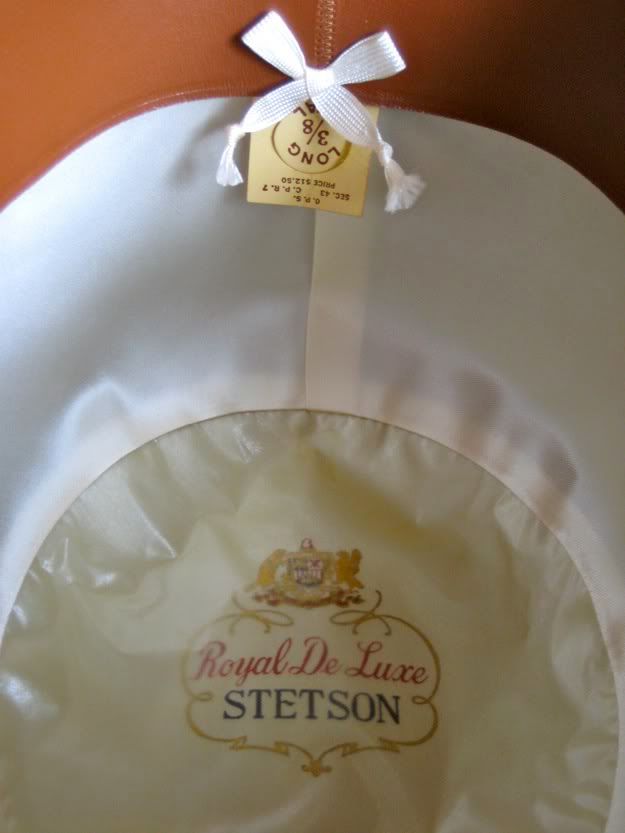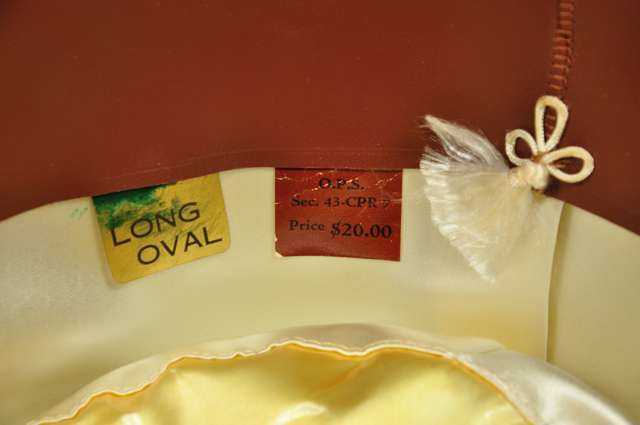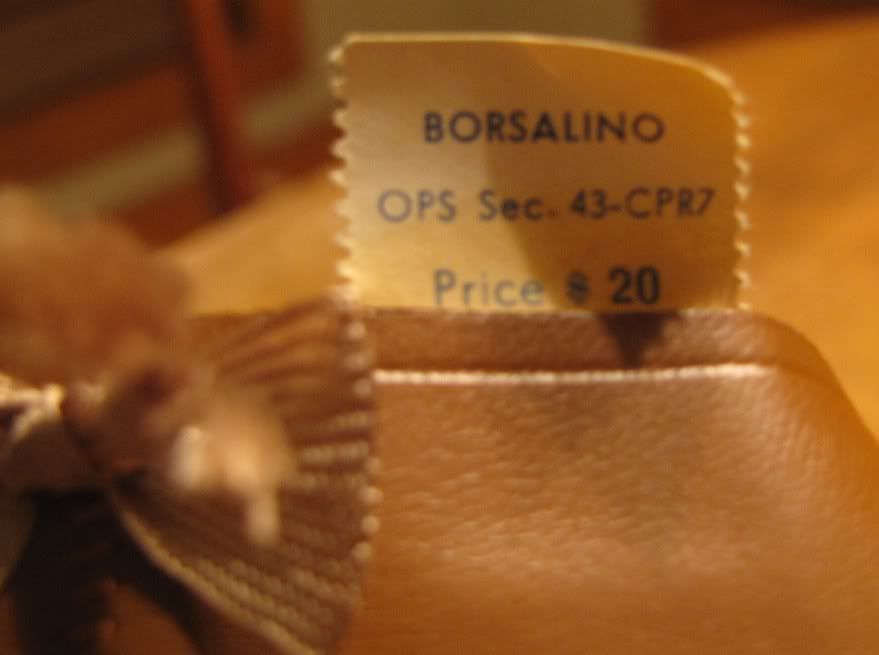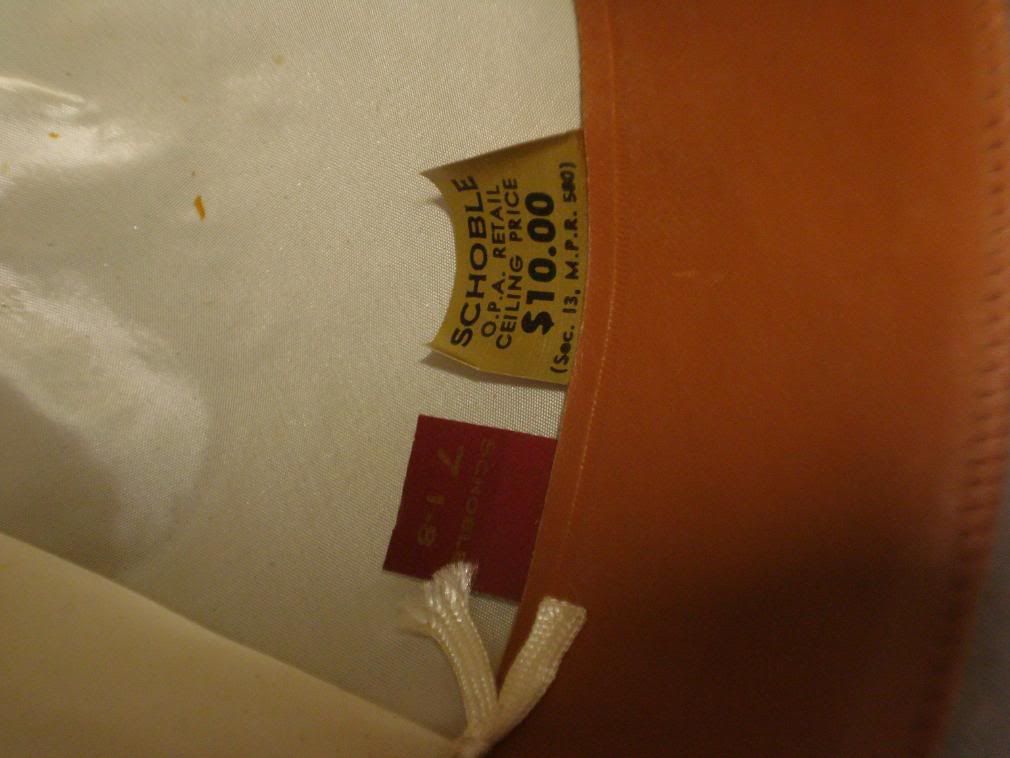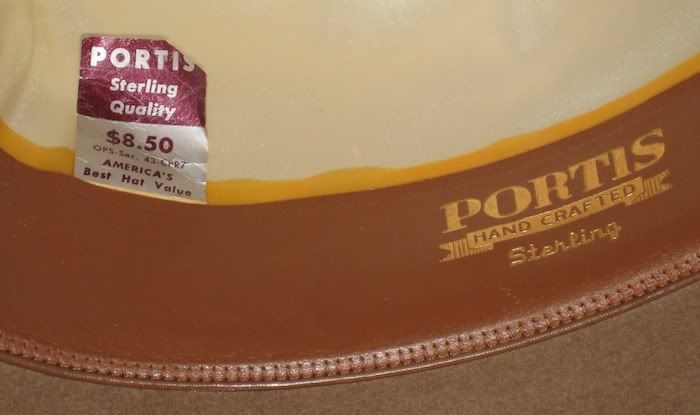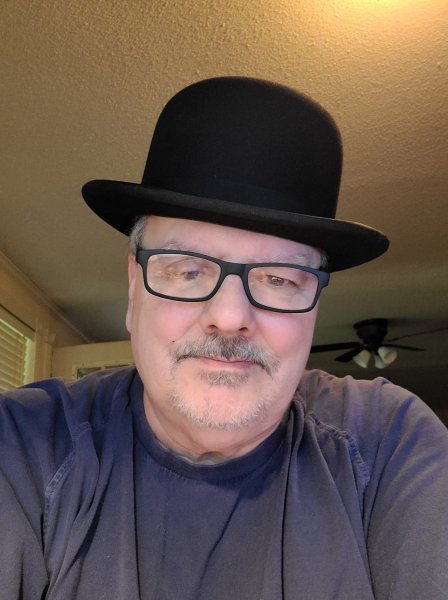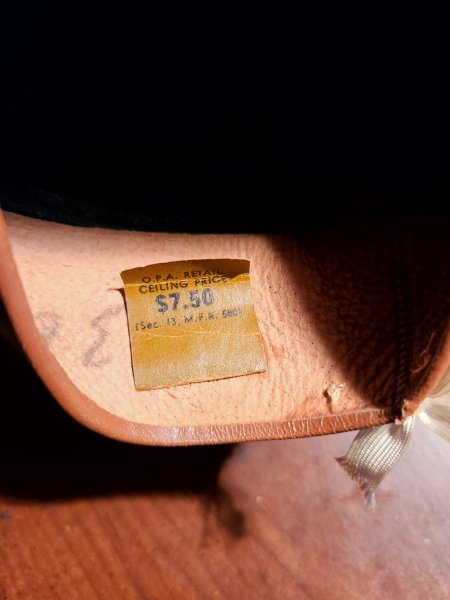Joshbru3
I'll Lock Up
- Messages
- 4,409
- Location
- Chicago, IL
Many of us on the lounge have seen hats with OPA tags and some with OPS tags. I know there has been lengthy discussion on these tags, but there is no thread SPECIFICALLY dedicated to them. I did a search of "Ceiling Price" and there's only one thread which shows an example. In the Stetson, Dobbs, Borsalino, etc threads, there have been pictures and examples. I think its important to have a thread that's specifically dedicated to them.
OPA Ceiling Price (1941 - 1947)
OPS Ceiling Price (1951 - 1953)
OPA (Office of Price Administration)
OPA EXPLANATION:
"Office of Price Administration (OPA) was the federal agency tasked with establishing price controls on nonagricultural commodities and rationing essential consumer goods during World War II (1939–1945).
The OPA began as the Price Stabilization and Consumer Protection divisions of the Advisory Commission to the Council of National Defense (more commonly known as the National Defense Advisory Commission [NDAC]) created on 29 May 1940 in response to economic pressures from the war in Europe. NDAC's influence was limited, with the Price Stabilization Division setting standards for only basic scrap metals. The Consumer Protection Division's rent-control proposals of 7 January 1941 were universally ignored.
On 11 May 1941, by Executive Order 8734, the Office of Price Administration and Civilian Supply (OPACS) was created from the two NDAC divisions. Leon Henderson, head of the Price Stabilization Division, was appointed as administrator and quickly dubbed in the media as the "Price Czar." Noted economist John Kenneth Galbraith was chosen to direct OPACS's Price Division and served in this function through 1943.
On 28 August 1941, Executive Order 8875 transferred the Civilian Supply group to the Office of Production Management to consolidate the similar efforts of the two entities. OPACS was renamed the Office of Price Administration.
OPA's efforts began in earnest with the outbreak of war on 7 December 1941. Because it had the existing structure to interact with retail outlets and consumers, OPA was delegated the task of rationing. On 27 December 1941 it instituted rationing of rubber tires. Directive Number One of the War Production Board made OPA's rationing role permanent, and by April 1942, rationing had extended to automobiles, sugar, typewriters, and gasoline. By the end of the war, the rationing program also included coffee, shoes, stoves, meats, processed foods, and bicycles.
The Emergency Price Control Act (EPCA) passed on 30 January 1942 provided the legislative basis for OPA to regulate prices, not including agricultural commodities. EPCA also allowed for rent controls. The most prominent result of EPCA was the General Maximum Price Regulation issued by OPA in May 1942. This effectively set the price ceiling at March 1942 levels.
However, EPCA did not address other economic issues beyond price controls. The resulting economic dislocations forced Congress to pass the Stabilization Act on 2 October 1942. This created the Office of Economic Stabilization (OES) that was responsible for controlling wage levels, regulating food prices, and generally stabilizing the cost of living. At this point, any OPA activities that could affect the cost of living had to be coordinated with OES.
The effectiveness of OPA's measures is subject to some debate. While OPA pointed to an overall 31-percent rise in retail prices in World War II compared to a 62-percent rise in World War I (1914–1918), undoubtedly a black market developed in response to price controls. Maintenance of product quality was a constant concern. OPA even colorfully noted in its Twelfth Quarterly Report "a renaissance of cattle rustlers in the West." Reports from OPA's Enforcement Division show that 650,000 investigations were conducted for all of 1943, with 280,000 violations found. In 1944, a total of 338,029 violations were reported, with 205,779 administrative warning letters sent out. Court proceedings were initiated in almost 29,000 cases.
Rationing for gasoline and foodstuffs was discontinued on 15 August 1945. All rationing ended by the end of September 1945. Price controls remained in effect in the hopes of preventing price instability as the war economy converted back to peacetime functions, but they were gradually discontinued through 1947. On 12De-cember 1946, Executive Order 9809 transferred OPA to the Office of Temporary Controls. While some sugar and rice control programs were transferred to the Department of Agriculture, most other OPA functions were discontinued. OPA was disbanded on 29 May 1947."
Article found at: http://www.answers.com/topic/office-of-price-administration
OPS (Office of Price Stabilization)
OPS EXPLANATION:
"Office of Price Stabilization also known as the Price Stabilization Board, was the federal agency whose task was to control prices during the Korean War.
The onset of hostilities on 25 June 1950 came as a complete surprise to Americans. Fear of a major conflict with the Soviet Union and still-fresh memories of rationing programs during World War II lead to massive hoarding and panic buying by both consumers and manufacturers. Retail sales for July 1950 increased by 8 percent. After the first month of the war, prices for coffee had increased 9 percent; tin, 26 percent; and rubber, 27 percent. Against this backdrop, on 19 July 1950, in a message to Congress detailing the progress of the war, President Harry Truman asked for limited economic powers to pursue mobilization efforts. This led to the Defense Production Act of 1950, which gave the president the option of imposing rationing and wage and price controls.
Initially, Truman tried to avoid imposing wage and price controls to slow inflation, instead pinning his hopes on credit controls and voluntary compliance. These hopes proved futile. By the end of September 1950, government figures showed that prices for a basket of twenty-eight commodities had increased by 25 percent since the beginning of the war. On 9 September 1951, Executive Order 10161 created the Economic Stabilization Agency (ESA) and Wage Stabilization Board (WSB). The order also allowed for a director of price stabilization under the aegis of the ESA. General Order Number 2 of the ESA formally established the Office of Price Stabilization on 24 January 1951, with Michael DiSalle, mayor of Toledo, as its administrator.
OPS's first act was to announce a price freeze on 26 January 1951. This stopgap measure proved unpopular and unwieldy, and, in many cases, OPS was forced to increase prices. It was not until April 1951 that OPS issued a long-range price control strategy. However, that plan also failed to gather popular support. OPS operations were hampered throughout its existence by the continuous debate over the appropriate level of mobilization and governmental economic control required for an undeclared war. Indeed, Allan Valentine, the first director of ESA, was opposed to establishing price controls. OPS also found many of its efforts undercut by salary rulings of the WSB, especially in the steelworkers' salary dispute of March 1952.
On 6 February 1953, President Dwight Eisenhower's Executive Order 10434 called for the end of all price and wage controls. OPS ended all activities on 30 April 1953 with residual operations passing to ESA."
Article found at: http://www.answers.com/topic/office-of-price-stabilization
OPA Ceiling Price (1941 - 1947)
OPS Ceiling Price (1951 - 1953)
OPA (Office of Price Administration)
OPA EXPLANATION:
"Office of Price Administration (OPA) was the federal agency tasked with establishing price controls on nonagricultural commodities and rationing essential consumer goods during World War II (1939–1945).
The OPA began as the Price Stabilization and Consumer Protection divisions of the Advisory Commission to the Council of National Defense (more commonly known as the National Defense Advisory Commission [NDAC]) created on 29 May 1940 in response to economic pressures from the war in Europe. NDAC's influence was limited, with the Price Stabilization Division setting standards for only basic scrap metals. The Consumer Protection Division's rent-control proposals of 7 January 1941 were universally ignored.
On 11 May 1941, by Executive Order 8734, the Office of Price Administration and Civilian Supply (OPACS) was created from the two NDAC divisions. Leon Henderson, head of the Price Stabilization Division, was appointed as administrator and quickly dubbed in the media as the "Price Czar." Noted economist John Kenneth Galbraith was chosen to direct OPACS's Price Division and served in this function through 1943.
On 28 August 1941, Executive Order 8875 transferred the Civilian Supply group to the Office of Production Management to consolidate the similar efforts of the two entities. OPACS was renamed the Office of Price Administration.
OPA's efforts began in earnest with the outbreak of war on 7 December 1941. Because it had the existing structure to interact with retail outlets and consumers, OPA was delegated the task of rationing. On 27 December 1941 it instituted rationing of rubber tires. Directive Number One of the War Production Board made OPA's rationing role permanent, and by April 1942, rationing had extended to automobiles, sugar, typewriters, and gasoline. By the end of the war, the rationing program also included coffee, shoes, stoves, meats, processed foods, and bicycles.
The Emergency Price Control Act (EPCA) passed on 30 January 1942 provided the legislative basis for OPA to regulate prices, not including agricultural commodities. EPCA also allowed for rent controls. The most prominent result of EPCA was the General Maximum Price Regulation issued by OPA in May 1942. This effectively set the price ceiling at March 1942 levels.
However, EPCA did not address other economic issues beyond price controls. The resulting economic dislocations forced Congress to pass the Stabilization Act on 2 October 1942. This created the Office of Economic Stabilization (OES) that was responsible for controlling wage levels, regulating food prices, and generally stabilizing the cost of living. At this point, any OPA activities that could affect the cost of living had to be coordinated with OES.
The effectiveness of OPA's measures is subject to some debate. While OPA pointed to an overall 31-percent rise in retail prices in World War II compared to a 62-percent rise in World War I (1914–1918), undoubtedly a black market developed in response to price controls. Maintenance of product quality was a constant concern. OPA even colorfully noted in its Twelfth Quarterly Report "a renaissance of cattle rustlers in the West." Reports from OPA's Enforcement Division show that 650,000 investigations were conducted for all of 1943, with 280,000 violations found. In 1944, a total of 338,029 violations were reported, with 205,779 administrative warning letters sent out. Court proceedings were initiated in almost 29,000 cases.
Rationing for gasoline and foodstuffs was discontinued on 15 August 1945. All rationing ended by the end of September 1945. Price controls remained in effect in the hopes of preventing price instability as the war economy converted back to peacetime functions, but they were gradually discontinued through 1947. On 12De-cember 1946, Executive Order 9809 transferred OPA to the Office of Temporary Controls. While some sugar and rice control programs were transferred to the Department of Agriculture, most other OPA functions were discontinued. OPA was disbanded on 29 May 1947."
Article found at: http://www.answers.com/topic/office-of-price-administration
OPS (Office of Price Stabilization)
OPS EXPLANATION:
"Office of Price Stabilization also known as the Price Stabilization Board, was the federal agency whose task was to control prices during the Korean War.
The onset of hostilities on 25 June 1950 came as a complete surprise to Americans. Fear of a major conflict with the Soviet Union and still-fresh memories of rationing programs during World War II lead to massive hoarding and panic buying by both consumers and manufacturers. Retail sales for July 1950 increased by 8 percent. After the first month of the war, prices for coffee had increased 9 percent; tin, 26 percent; and rubber, 27 percent. Against this backdrop, on 19 July 1950, in a message to Congress detailing the progress of the war, President Harry Truman asked for limited economic powers to pursue mobilization efforts. This led to the Defense Production Act of 1950, which gave the president the option of imposing rationing and wage and price controls.
Initially, Truman tried to avoid imposing wage and price controls to slow inflation, instead pinning his hopes on credit controls and voluntary compliance. These hopes proved futile. By the end of September 1950, government figures showed that prices for a basket of twenty-eight commodities had increased by 25 percent since the beginning of the war. On 9 September 1951, Executive Order 10161 created the Economic Stabilization Agency (ESA) and Wage Stabilization Board (WSB). The order also allowed for a director of price stabilization under the aegis of the ESA. General Order Number 2 of the ESA formally established the Office of Price Stabilization on 24 January 1951, with Michael DiSalle, mayor of Toledo, as its administrator.
OPS's first act was to announce a price freeze on 26 January 1951. This stopgap measure proved unpopular and unwieldy, and, in many cases, OPS was forced to increase prices. It was not until April 1951 that OPS issued a long-range price control strategy. However, that plan also failed to gather popular support. OPS operations were hampered throughout its existence by the continuous debate over the appropriate level of mobilization and governmental economic control required for an undeclared war. Indeed, Allan Valentine, the first director of ESA, was opposed to establishing price controls. OPS also found many of its efforts undercut by salary rulings of the WSB, especially in the steelworkers' salary dispute of March 1952.
On 6 February 1953, President Dwight Eisenhower's Executive Order 10434 called for the end of all price and wage controls. OPS ended all activities on 30 April 1953 with residual operations passing to ESA."
Article found at: http://www.answers.com/topic/office-of-price-stabilization
Last edited:

